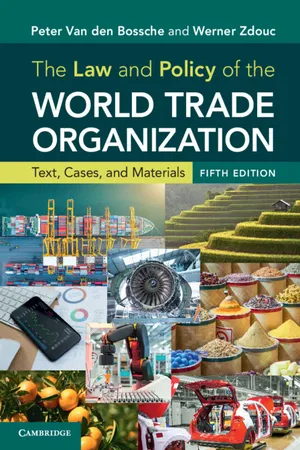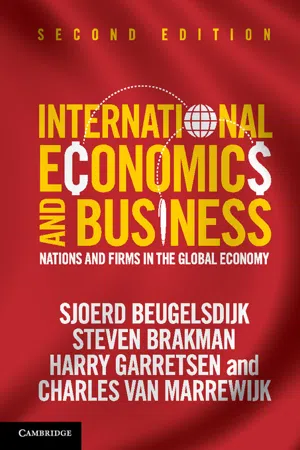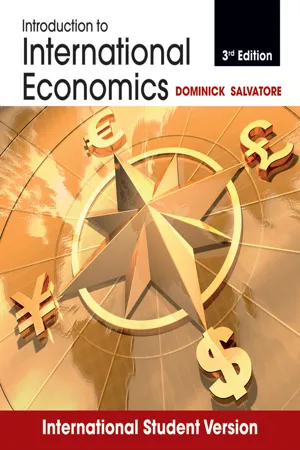Economics
Barriers to Trade
Barriers to trade refer to any government-imposed restrictions or obstacles that hinder the free flow of goods and services between countries. These barriers can take the form of tariffs, quotas, subsidies, or regulations, and are designed to protect domestic industries from foreign competition. By limiting imports, barriers to trade can impact consumer choices, increase prices, and reduce overall economic efficiency.
Written by Perlego with AI-assistance
Related key terms
1 of 5
10 Key excerpts on "Barriers to Trade"
- eBook - ePub
- Douglas Evans, Richard Body(Authors)
- 2017(Publication Date)
- Routledge(Publisher)
II ECONOMIC BARRIERS TO WORLD PROBLEMSPassage contains an image
DAVID ROBERTSON4. NON-TARIFF Barriers to TradeAs tariffs have been reduced by successive rounds of multilateral negotiations in the GATT, and selectively in discriminatory trade blocs, it has become apparent that other Barriers to Trade have become relatively more significant. These so-called non-tariff barriers are remarkable for their diversity, and in the eyes of some commentators they are now more important than remaining tariffs in their impact on trade flows. The wide variety of measures considered as non-tariff barriers has been most completely revealed in regional trade blocs, like the EEC and EFTA, where the elimination of tariffs has exposed these alternative instruments of protection. Some attempts have been made in these regional blocs to harmonise national policies to reduce the effects of non-tariff barriers. There is a danger, however, that this will intensify the trade-distorting effects on outsiders. Since non-tariff barriers exist in all countries, it would be more appropriate if attempts to modify or remove such trade-distorting policies took place in a multilateral framework.‘Non-tariff barriers’ is a collective term for the whole range of government policy measures and practices which operate deliberately, or sometimes only incidentally, to restrain imports or to distort exports. Some of these measures are specifically designed to impede imports, such as import quotas and customs administration charges. In addition, some imports are affected, perhaps unintentionally, by domestic laws and regulations, such as health and safety standards, trade-marking and local government procurement regulations. Trade patterns are also distorted by domestic assistance programmes, which not only help import-competing industries but also promote exports, as well as by measures aimed at subsidising exports through tax incentives and favourable financing. Thus, the term ‘non-tariff barriers’ comprises both trade restricting measures and trade promoting measures. (‘Non-tariff distortions’ has been suggested as a more accurate description,1 - No longer available |Learn more
- International Trade Centre(Author)
- 2002(Publication Date)
- United Nations Publications(Publisher)
• Services barriers (e.g. prohibitions on imports, screen time quotas for foreign films, requirements that imports should be carried by national flag vessels, limited access to retail markets for distributors, discriminatory rules on the recognition of diplomas and professional experience). • Restrictions on foreign direct investments (e.g. limitations on foreign equity participation, local content and export performance requirements, and restrictions on transferring earnings and capital). Source: Office of the United States Trade Representative (1994), Foreign Trade Barriers, Washington D.C., US Government Printing Office, pp. 1-2. © International Trade Centre 2000 regulation – whether or not it is prohibited under GATT – can be contested if it acts to deny a benefit granted by the country concerned under the WTO Agreements (Hoekman, Mavroidis 1994). Barriers at the domestic border The public debate on Barriers to Trade focuses on barriers to entry in foreign markets. Yet, managers in many developing countries perceive domestic regulatory barriers to be even greater hindrances to the export trade ( see box 2.5). Box 2.5 Barriers to exporting at the border of the developing country In many developing economies, the real issue is to get the exported product through the border controls in the country of exportation. Certain products require burdensome documentation, especially if they are traded under a preferential scheme. In some countries export managers bitterly complain about ill-conceived duty drawback schemes which impose too short a delay between the importation of inputs and the export of products in which those inputs are embodied (ideally, the scheme should permit a repayment of tariffs on imported inputs). In other countries, managers complain that businessmen are perceived by customs officers as thieves or that smaller entrepreneurs are discriminated against. - eBook - PDF
The Law and Policy of the World Trade Organization
Text, Cases and Materials
- Peter Van den Bossche, Werner Zdouc(Authors)
- 2017(Publication Date)
- Cambridge University Press(Publisher)
See below, pp. 499–503. 2 See also Roy Santana and Lee Ann Jackson, ‘Identifying Non-Tariff Barriers: Evolution of Multilateral Instruments and Evidence from the Disputes (1948–2011)’, World Trade Review, 2012, 465. 3 On tariff Barriers to Trade in services, see above, p. 416. As discussed, tariff Barriers to Trade in services do not currently exist, but the debate, and the current WTO moratorium, on the ‘bit tax’, i.e. a tax imposed ‘at the border’ on electronic communications containing services outputs, shows that tariff barriers can exist for trade in services. 4 See below, pp. 893, 894 and 935–7. Note also that this chapter does not deal with non-tariff Barriers to Trade resulting from the lack of effective protection of intellectual property rights. The WTO rules addressing these barriers, i.e. the WTO rules ensuring a minimum level of protection and enforcement of intellectual property rights, are dealt with in Chapter 15. See below, p. 1042. 1 INTRODUCTION As mentioned in Chapter 6, not only tariff barriers but also a wide range of non-tariff barriers restrict trade. 1 While tariff barriers were systematically reduced since the late 1940s as a result of successive rounds of tariff nego- tiations, non-tariff barriers have in recent decades gradually become an ever more prominent instrument of protection. The term ‘non-tariff barrier’ is not defined in WTO law, but this important residual category of Barriers to Trade can be understood to include all government imposed and sponsored actions or omissions that act as prohibitions or restrictions on trade, other than ordinary customs duties and other duties and charges on imports and exports. 2 Unlike tariff barriers, non-tariff barriers not only affect trade in goods but also trade in services. - eBook - PDF
- Dominick Salvatore(Author)
- 2012(Publication Date)
- Wiley(Publisher)
International trade is also hampered by numerous technical, adminis- Concept Check What are other nontariff trade barriers? What are their effects? trative, and other regulations. These include safety regulations for automobile and electrical equipment, health regulations for the hygienic production and packaging of imported food products, and labeling requirements showing ori- gin and contents. While many of these regulations serve legitimate purposes, some (such as the French ban on Scotch advertisements and the British Technical, admin- istrative, and other regulations Non- tariff trade barriers such as safety, health, labeling require- ments, and border taxes. restriction on the showing of foreign films on British television) are only thinly veiled disguises for restricting imports. Other trade restrictions have resulted from laws requiring governments to buy from domestic suppliers (the so-called government procurement policies). For example, under the ‘‘Buy American Act’’ passed in 1933, U.S. government agencies gave a price advantage of up to 12 percent (50 percent for defense contracts) to domestic suppliers. As part of the Tokyo Round of trade liberalization discussed in Section 6.8, the United States and other nations agreed on a government procurement code to bring these practices and regulations into the open and give foreign suppliers a fair chance. Much attention has also been given in recent years to border taxes. These are rebates for internal indirect taxes given to exporters of a commodity and imposed (in addition to the tariff) on importers of a commodity. Examples of indirect taxes are excise and sales taxes in the United States and the value-added tax (VAT) in Europe. - eBook - PDF
The Law and Policy of the World Trade Organization
Text, Cases, and Materials
- Peter Van den Bossche, Werner Zdouc(Authors)
- 2021(Publication Date)
- Cambridge University Press(Publisher)
522 Non-Tariff Barriers 7 1 INTRODUCTION As mentioned in Chapter 6, not only tariff barriers but also a wide range of non-tariff barriers restrict trade. 1 While tariff barriers were systematically reduced since the late 1940s as a result of successive rounds of tariff negoti- ations, non-tariff barriers have in recent decades gradually become an ever more prominent instrument of protection. The recent increase in customs duties by some WTO Members in the context of trade wars or otherwise does not negate this trend of the heightened importance of non-tariff barriers as an instrument of protection. The term ‘non-tariff barrier’ is not defined in WTO law, but this important residual category of Barriers to Trade can be understood to include all govern- ment-imposed (or sponsored) actions or omissions that act as prohibitions or restrictions on trade, other than ordinary customs duties and other duties and charges on imports and exports. 2 Unlike tariff barriers to date, non-tariff barriers not only affect trade in goods but also trade in services. 3 This chapter deals in turn with: (1) quantitative restrictions on trade in goods; (2) ‘other non-tariff barriers’ on trade in goods; (3) market access Barriers to Trade in services; and (4) other Barriers to Trade in services. Note, however, that this chapter does not deal with two specific types of ‘other non-tariff barriers’ to trade in goods, namely, technical Barriers to Trade and sanitary and phyto- sanitary measures. Due to their importance and detailed nature, the rules on these ‘other non-tariff barriers’ are discussed, separately, in Chapters 13 and 14, 1 In this book, the term ‘non-tariff barrier’ (NTB) encompasses the term ‘non-tariff measure’ (NTM). However, the term ‘non-tariff barrier’ is broader than the term ‘non-tariff measure’, as it also includes Barriers to Trade other than measures, such as the lack of transparency. - eBook - ePub
How Developing Countries Trade
The Institutional Constraints
- Sheila Page(Author)
- 1994(Publication Date)
- Routledge(Publisher)
3NON-TARIFF BARRIERS
International diversion
DEFINITION, AND HOLES IN THE THEORY AND THE MEASUREMENT
Most of the increase in protection after 1974, particularly by industrial countries, was not in tariffs. The restrictions imposed by the GATT system (and in some cases regional organisations) on the permitted level of tariffs, on autonomous national changes, and on discrimination among suppliers, led to a search for substitutes.The barriers which are normally included in NTBs include quotas, licences or other types of surveillance, price administration, restraints on purchases of foreign goods, and administration of any non-trade controls in a way intended to deter imports. The most important are quotas which exist on a formal basis: import controls, fully quantified (the best known example is in textiles and clothing) or in some cases (e.g. in some agricultural trade) subject to variation with production or prices. These account for most of the measurement of recorded barriers, partly because they are most used, and partly because some of the other recognised NTBs (limits on public purchasing, for example) cannot easily be allocated to individual import categories. Administrative barriers may be difficult to distinguish from careful observance of legitimate health or safety rules or from inefficiency. Much discussion concentrates on import quotas, but export quotas (or variants of this) are also non-tariff barriers. As the international data used here are collected by the importing country and concentrate on their limits on imports, this chapter will focus on these interventions. Individual country export controls on some products (typically primary products for reasons of either security, food or military, or to promote domestic processing) are being reduced or eliminated, and no measurement will be made. Most are no longer sufficiently important to influence the trading patterns or prospects of other countries, and are therefore not relevant. The export controls which do, at least potentially, affect the trade of other countries are the remaining commodity agreements, tied aid and controls on trade with the ex-centrally planned economies. These are discussed in Chapter 5 - eBook - PDF
- Dominick Salvatore(Author)
- 2020(Publication Date)
- Wiley(Publisher)
Furthermore, foreign exporters may absorb all or part of the tariff by increasing their efficiency of operation or by accepting lower profits. As a result, the actual reduction in imports may be less than anticipated. Exporters cannot do this with an import quota since the quantity of imports allowed into the nation is clearly specified by the quota. It is for this reason, and also because an import quota is less “visible,” that domestic producers strongly prefer import quotas to import tariffs. However, since import quotas are more restrictive than equivalent import tariffs, society should generally resist these efforts. As we will see in Section 9.7A, one of the provisions of the Uruguay Round was to change import quotas and other nontariff barriers into equivalent tariffs (a process known as “tariffication”). 9.3 Other Nontariff Barriers and the New Protectionism In this section, we examine trade barriers other than import tariffs and quotas. These include voluntary export restraints and technical, administrative, and other regulations. Trade restrictions also result from the existence of international cartels and from dumping and export subsidies. During the past two decades, these nontariff trade barriers (NTBs) , or the new protectionism , have become more important than tariffs as obstructions to the flow of international trade and represent a major threat to the world trading system. In this sec-tion, we examine NTBs and the new protectionism, starting with voluntary export restraints. 9.3A Voluntary Export Restraints One of the most important of the nontariff trade barriers, or NTBs, is voluntary export restraints (VERs) . These refer to the case where an importing country induces another nation to reduce its exports of a commodity “voluntarily,” under the threat of higher all- around trade restrictions, when these exports threaten an entire domestic industry. - eBook - ePub
- (Author)
- 2023(Publication Date)
- Wiley(Publisher)
Capital restrictions are defined as controls placed on foreigners’ ability to own domestic assets or domestic residents’ ability to own foreign assets. Thus, in contrast with trade restrictions, which limit the openness of goods markets, capital restrictions limit the openness of financial markets and will be addressed later.3.1. Tariffs
Tariffs are taxes that a government levies on imported goods. The primary objective of tariffs is to protect domestic industries that produce the same or similar goods. They also may aim to reduce a trade deficit. Tariffs reduce the demand for imported goods by increasing their price above the free trade price. The economic impact of a tariff on imports in a small country is illustrated in Exhibit 1 . In this context, a small country is not necessarily small in size, population, or GDP. Instead, a small country is one that is a price taker in the world market for a product and cannot influence the world market price. For example, by many measures, Brazil is a large country, but it is a price taker in the world market for cars. A large country, however, is a large importer of the product and can exercise some influence on price in the world market. When a large country imposes a tariff, the exporter reduces the price of the good to retain some of the market share it could lose if it did not lower its price.This reduction in price alters the terms of trade and represents a redistribution of income from the exporting country to the importing country. So, in theory, it is possible for a large country to increase its welfare by imposing a tariff if (1) its trading partner does not retaliate and (2) the deadweight loss as a result of the tariff (see below) is smaller than the benefit of improving its terms of trade. Global welfare, however, would still experience a net reduction—the large country cannot gain by imposing a tariff unless it imposes an even larger loss on its trading partner. - eBook - PDF
International Economics and Business
Nations and Firms in the Global Economy
- Sjoerd Beugelsdijk, Steven Brakman, Harry Garretsen, Charles van Marrewijk(Authors)
- 2013(Publication Date)
- Cambridge University Press(Publisher)
In fact, as discussed below, this constitutes the rationale for the existence of the World Trade Organization, as trade impediments are unlikely to be overcome without such institutions. Similarly, the degree of international capital mobility has clearly increased recently (see Chapter 2 ), although many countries still have capital restrictions in place or consider (re-)installing them when confronted with financial mayhem. The main question we address in this chapter is why trade restrictions exist if theory often dictates that they should not. In answering this question, we may come to a better understanding of the pleas for trade restrictions. We shall conclude that it is by and large welfare-decreasing to give in to these pleas. Learning objectives * The prevalence of trade protection * The various types of protectionist measures * The welfare consequences of trade protection * Why it is so difficult to get rid of protection in practice 5.2 Tariffs and trade restrictions ............................................................................ Trade restrictions, such as tari ff s, have been falling on a global scale for a long time. To a large extent, the fall in trade restrictions can be attributed to the work of the General Agreement on Tari ff s and Trade, a multilateral organization which has now trans-formed itself – since 1995 – into the World Trade Organization. In a long series of multilateral trade negotiation rounds the average tari ff rate (all goods) has been falling at the world level from about 8.71 per cent in 1988 to 2.69 per cent in 2010 ( Figure 5.1 ). The reasons for the introduction and reductions of tari ff s can be varied for individual countries, as we illustrate for the USA. Figure 5.2 shows that tari ff s in the USA have, on average, been declining for a long period. However, the fi gure also shows periods in which tari ff s were raised. - eBook - PDF
- Dominick Salvatore(Author)
- 2014(Publication Date)
- Wiley(Publisher)
Europe has increased protection on a number of industries out of fear of turning into an industrial wasteland. Russia raised tariffs on used car imports, India banned Chinese toys, and Argentina has tightened licensing requirements on auto parts imports, textiles and leather goods. The United States and some European countries are subsidizing their embattled automakers and car dealers. A second problem is that subsidies and tariffs on agricultural products remain very high; antidumping measures and safeguards are still possible and frequently abused, and the potential for serious trade disputes remains. A third trade problem is the tendency for the world to break up into three major trading blocs: the European Union (EU), the North America Free Trade Area (NAFTA), and a (much less defined) Asian bloc (trading blocs are examined in detail in the next chapter). Although these trading blocs could be regarded as building blocks of a freer trading system, they can also become stumbling blocks and lead to more bilateral deals, protectionism, and interbloc trade conflicts. The fourth problem is the call by some developed countries, such as the United States and France, for the establishment of labor and environmental standards. These are supposed to ensure a ‘‘leveling of working conditions’’ between developed and developing countries and avoid ‘‘social dumping’’ by the latter (i.e., developing countries competing unfairly by denying their workers basic rights and decent wages and working conditions). The danger is that the movement to establish labor and environmental 158 Part Two International Trade Policy standards can easily be captured by protectionistic forces. The same is true Concept Check What are the major trade problems facing the world today? for environmental standards (see Section 4.10).
Index pages curate the most relevant extracts from our library of academic textbooks. They’ve been created using an in-house natural language model (NLM), each adding context and meaning to key research topics.









